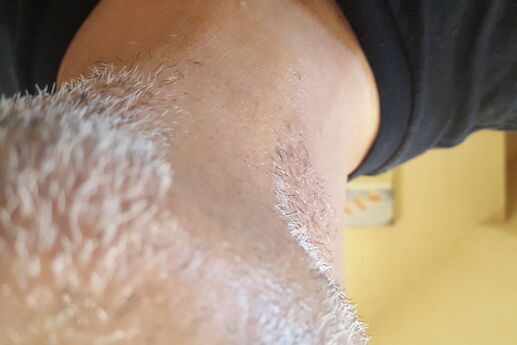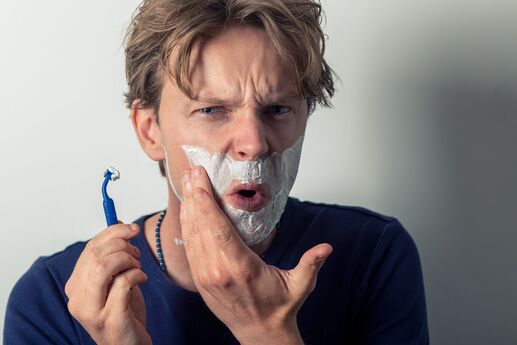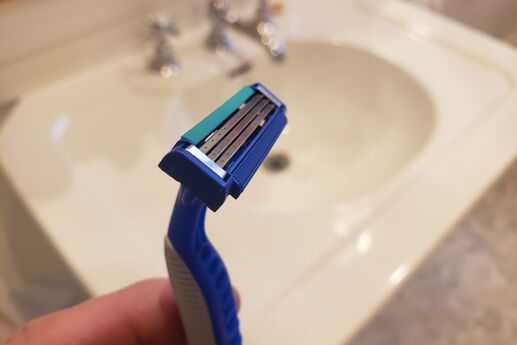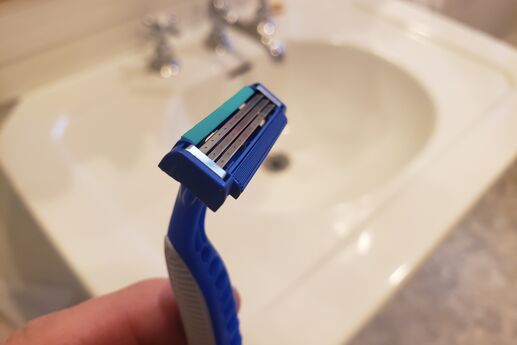So, in the old days when shaving was a boring, mundane daily routine that just had to be done and not really thought about too much, scrapes, cuts and razor burn just came with the territory. No one griped about it. But now, with fancy new technology (5 blades!), comfort strips and lubrication gel strips, shaving is more like a men’s home care New Year’s Eve party. And why not? The Men’s personal care industry has exploded in the last 10 years and many of the razor & blade manufacturers, shave and after shave balm makers and skin care players are all chasing market share. Heck, Dollar Shave Club is selling butt wipes for Pete's sake, so clearly there is opportunity for the brands to solidify their loyalties with their base. Proctor & Gamble, Unilever and Edgewell are the big players, but there are upstarts like Harry's who are competing to penetrate the coveted recurring cartridge subscriber. The irony is that despite the massive upgrades in gear, blades, cartridges, shave cream and aftershave lotions, people are shaving a whole lot less. Indeed, many of today’s ad pitchmen are bearded Millennials who apparently feel the need to remind the American public that they don’t have to shave for the jobs they may or may not have. But for now we are going to attempt to break down the question of which blade is best, both from a quality and performance standpoint, and from a cost standpoint.
Our collective jaws dropped last year when we read about Dollar Shave Club being acquired for $1 Billion by Unilever. And then we all scratched our heads when Harry’s went on a PR tour about the blade factory in Germany they bought. And it is worth noting that subscription-based services, like those offered by Dollar Shave Club, Harry’s and now Gillette OnDemand, are less about a quality shave and more about having your credit card on file to charge every month. There is a good reason the Dollar Shave Club founder Michael Dubin made such entertaining commercials: because he wanted your credit card.
Methodology
I did okay in middle school and high school science, and so I know a little bit about the idea of a ‘control’ to perform a proper scientific experiment. So I realized that before I lay out my findings on the increasingly costly modern shave set-ups, that I would lay out the rating systems and methodology so that there are no gray areas of misunderstandings. And, since this article will be published and translated into 5 different languages, I don’t want to offend anyone.
First, to establish a control I decided that each razor would shave three times: 1) the first time on a 72 hour beard, 2) the second time on a 48 hour beard (same blade), and the third time on a 24 hour beard. I wanted to do it this way to see how durable the blade was and how well it held up as its performance deteriorated and to measure the all-important ‘cost-per-awesome-shave metric’ I wanted to introduce. I say this because every man in the world who is reading this has extracted an extra shave or two or three from an old dull razor. And that is usually because he is out of blades, which is likely because they cost so much damn money and he didn’t feel like trading his financial security for a decent shave (this could also could explain why so many men are wearing beards these days.)
Quick sidebar: I was speaking with my father the other day about the 70’s when men his age wore sideburns and mustaches and long hair if they had it as a means of protest and display of civil disobedience. He told me that NOT shaving was never an option back in the day, and that men demonstrated their defiance and civil disobedience via mustached and hippie mullets (see season 1 of HBO’s Vinyl for a visual representation of this). But I didn’t care (and still don’t), but I do care about figuring out the best razor/shave set-up best for you, the reader.
Okay back to the methodology. I selected Jack Black’s Beard Lube as my shave cream/lube because I have used it in the past and I felt like its eucalyptus scent and cooling feel best represented what readers wanted out of a good shave. I also have noticed in my 30 plus years of shaving that I would rather have a slightly less close shave than a painful cut on my face, and that most men (or women) reading this this will agree. Blood is bad, comfort is good. Finally, to make each blade’s performance an apples-to-apples comparison to its competitor, they need to have the same whisker length and whisker toughness.
Gillette
I thought the Mach 3, the Dodge Charger Daytona of razors, was pretty great when it came out in 1995. And shaving with it was about the coolest thing I could have imagined. I never thought they’d get three blades into a cartridge, and then when they got 5 blades into a cartridge I figured the razor blade wars were over. But those Gillette razor cartridges are not cheap, and still aren’t. A package of 8 new Gillette Fusion replacement blade cartridges goes for between $28 and $32 on Amazon. As usual, this was a great, comfortable shave. The lubrication strip lasted longer than I expected, and the blades stayed sharp through the third shave. The Fusion cartridges also comes with a blade at the top of the cartridge, above the comfort strip, that is great for getting whisker up under your nose. I also like the design of the head for easy cleaning. Overall, even with Gillette’s new direct subscription option, these blades are pricey.
Dollar Shave Club
Dollar Shave Club has a 6 blade cartridge that sells for $9 per month for four cartridges. I really like this shave, and the blades held up well in three times I used the cartridge. What I didn’t really like is the silly marketing and overly complex pricing and subscription tiers. In general, I don’t like having my credit card getting hit every month for something I may not need. I don’t shave as much as I used to, and I want to buy razors when I need them, not when my razor company wants to charge me. Plus, as with any subscription business, there is the ever present lead generation and free sampling that bothers me.
Harry’s
Harry’s offers a few different options as well, but we used the 5 blade option for this exercise. The packing is nice (blue, orange or green handle), but until shaving gear becomes a fashion statement, then the color of the handle doesn’t and shouldn’t matter. What should matter is how close a shave you get, how many shave you can get get from one cartridge, and what the Cost-per-Awesome- Shave (CPAS) is. I liked this shave, but I noticed the blades wore down at a slightly higher rate then the others. I also felt like the website was clunky and didn’t really boil down the all-in costs of ordering a shipment. In general, anytime there is a shipping costs involved, there is room for padding costs.
Schick
The Schick Hydro came our in 2010 and has earned some respect among face shavers. Without over spending on branding and instead focusing on value and quality, Schick has been able to hold onto precious market share in the US while the Big Three beat each other up with media dollars. The truth is, Schick offers and excellent shave at a decent price, and enjoys brand loyalty not only in the US but around the globe. The Schick Hydro 5 performed very well in our comparison, and at $15 on Amazon for a package of 5 new blades, are priced reasonably.
Bic
Ahh the old standby. One blade, one use, throw away. Easy, no gimmicks, no flash, no commercials and, sadly, not a very comfortable shave. The blade will work fine with a decent shave balm on a 1-day beard, but any real stubble and you are in trouble. This shaving experience fit squarely in the ‘you get what you pay for’ bucket, and most men with a face will want to pay a little more for comfort.
| |
Comfort |
Durability |
Price |
CPAS* |
| Dollar SC |
3.5 |
3.5 |
5.0 |
3.9 |
| Gillette |
5.0 |
5.0 |
3.5 |
4.6 |
| Harry's |
3.5 |
4.0 |
4.0 |
3.8 |
| Bic |
2.0 |
2.0 |
5.0 |
2.8 |
| Schick |
4.0 |
4.0 |
4.0 |
4.0 |
* We discussed putting in an actual dollar amount in here but given small price fluctuations, shipping, and free shave cream samples, decide to keep it simple and give an overall grade between 1 and 5. We also overweighted 'comfort' in the calculation of CPAS by @2X
To summarize, Gillette, Schick, Dollar Shave Club and Harry’s are making shaving a lot less boring and a lot more exciting for most men. But in the end, most men want a good shave (when they have to shave) at a reasonable cost without too many bells and whistles. We preferred Gillette, but as with everything, to each his own.






